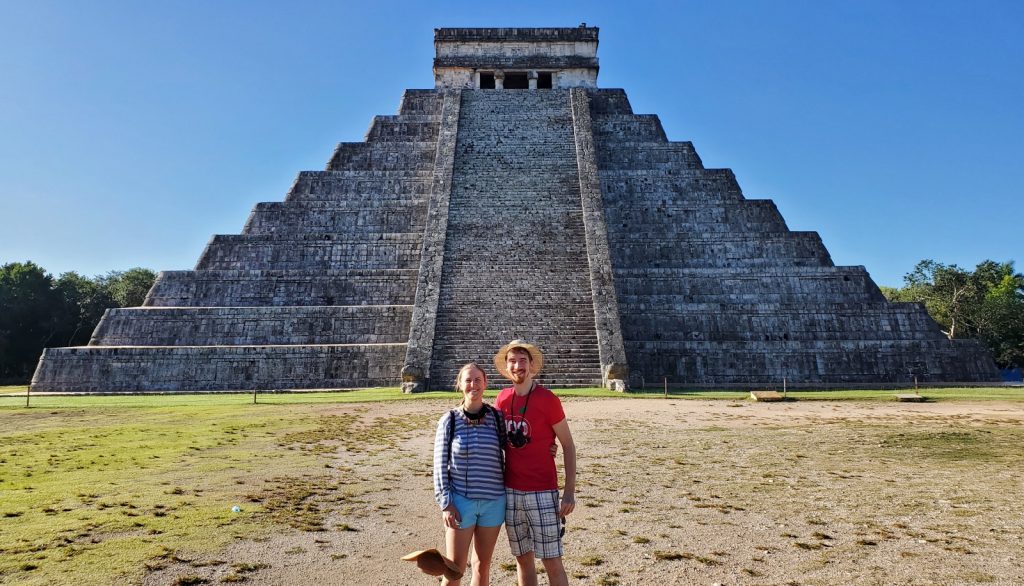
Another excuse to go to Mexico! Christine and I have been several times before, but this is the first time we’ve had a honeymoon. Over the past several months we’d been looking around for places to travel to while she had her Christmas break, but thanks to COVID, Mexico was an easy thing to settle on – namely due to the low prices (we got tickets for $187 apiece round trip) and the lack of a mandatory 14-day quarantine. We want to go visit my foreign exchange sister Farah in South Korea, but the quarantine they require pretty much kills any chance of a trip for pleasure. Which to be honest, is probably as it should be during a global pandemic.
While Christine had been to the Yucatan peninsula twice before, this was my first visit. While the temperature hasn’t been too bad in Wisconsin thus far, it was still nice to get to tropical climates. After arriving at the Cancun airport, we had initially planned to take the 5 dollar (approximately) “ADO” branded bus from the airport past the “Zona Hotelera,” the huge North-South running strip of gorgeous beach running along the eastern coast of the Mexican state of Quintana Roo, to get to Central Cancun, where we had our first night’s hotel before heading on to the Yucatan State Capitol of Merida. However, despite the bus company’s website stating that buses would run until 11:45 at night and us stepping out into the humid air at 11pm, the taxi drivers were more than happy to inform us that the buses had stopped for the evening, and “you are at our mercy” was not stated, but subtly implied.
We knew the Mexican cartels control the transport system around Cancun (Uber and other ride-share systems simply do not exist in Cancun, like they do in other parts of Mexico, due to High Chances of Messy Decapitation) so we didn’t bother arguing too much. We took our “private” taxi for $15 per person up to Central, although the hustlers at the taxi center suddenly crammed another 3 backpacking young people into our cab (all English speakers from Europe, who told us they were also told they were getting a “private” taxi for $15 each) and necessitated several long waits in heavy traffic along the Hotel Zone.
Our first night’s stay was quiet and relaxing in an “eco-hotel” – a refreshing return to one of my favorite aspects of Mexican and Spanish (and Arabic, let’s be honest – thanks Moors!) architecture, the unassuming front of the building hiding a gorgeously appointed interior courtyard with fountains and gardens everywhere. A quick foot-dip in the pool and breakfast, and we were on to the central bus station of Cancun (we had chosen the hotel because it was a 5 minute walk to the bus station) and a 3 hour ride to Merida.
Our hotel in Merida was called the Mission of Friar Diego. I had never heard of this Spanish fellow, but the stately convent-converted-to-hotel had lots of helpful plaques, artwork, statues, and signs to give some history. Apparently several hundred years ago he performed an “act of faith” for the Mayan people, by helpfully burning thousands of religious books and objects to better focus their attention on his god. He was later granted the Bishopric of the region by the Spanish crown for this action. Fast forward to now, and I’m not entirely sure how the hotel’s owners were presenting this guy; as neutrally as possible, it seemed. The room was nice though; having 2 foot thick stone walls really kept the place comfortably cool and quiet.
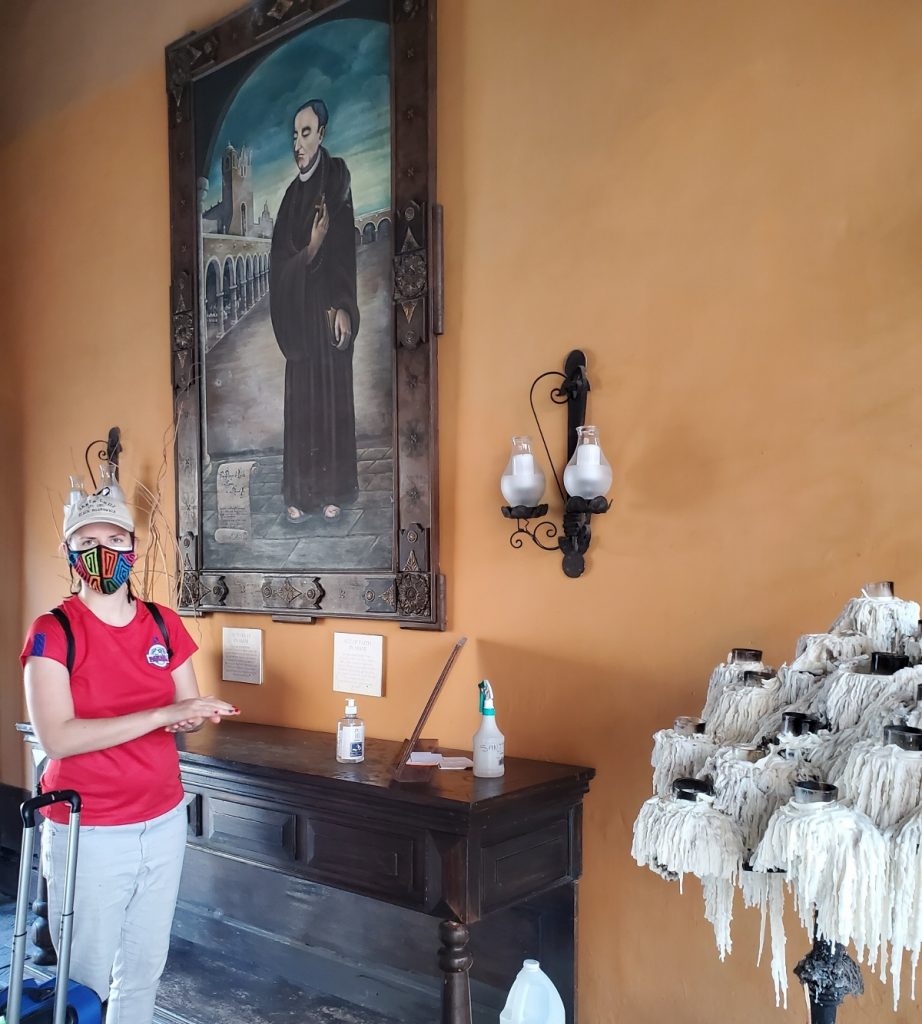
For our first day in Merida, a young Mestizo (Mayan/Spanish descended) man named Gus gave us a cooking class. We were joined a quartet of 20-something Germans, two brothers and their girlfriends on vacation. Gus freely admitted to us that this was his first time leading his class again in a year and a half since the pandemic began. He and his elderly aunt had run it out of her home for several years, but due to her advanced age he didn’t want to risk her health with guests, so we’d instead be using his friend Joachim’s kitchen.
Our previous Mexican cooking class experience in Oaxaca several years ago had begun in the local market, and Gus’s class was the same: the bustling central market does indeed seem to be a hallmark of Mexican culture. Throughout our time in Mexico, people did a great job of keeping their masks on, even outside in public – from what we could tell it was until recently mandated to wear masks even while outside, but that had been relaxed somewhat. 18 month habits die hard though, and it seemed 60-80% of people kept up the practice. Inside in the market, it was closer to 95-99% – which was good, because the aisles were tightly packed.
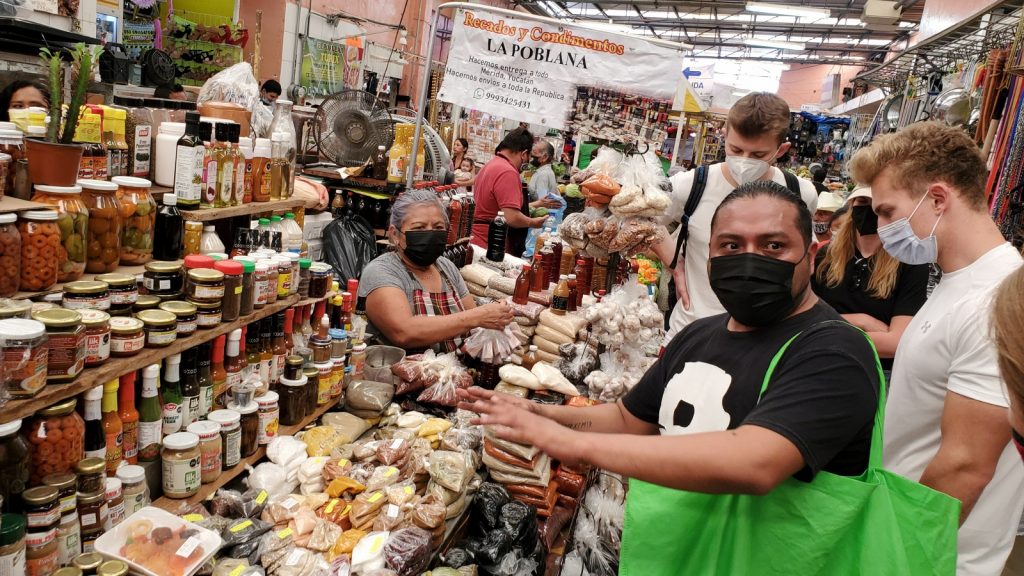
We saw lots of fresh hot sauce for sale, and surprising numbers of radishes. Proprietary and exotic blends of red, black, green, and brown spices, mixed with oil and water to make it a sticky and grainy paste, were sold in plastic bags. Most interesting to me was a rickety, almost steam-punk looking corn tortilla making machine in one stall – its owners would feed in the stone-ground cornmeal dough into a chute on the top, where it’d be flattened and exuded into a thin sheet on a drum underneath, where two disc blades sliced the sheet every 6 inches into two neat circles and recycled the excess back into the drum. The twin baby tortillas would drop onto a semi-circular grated conveyor belt which was precisely long enough to run the sets of twins under a long upper and lower burner, perfectly toasting them by the time they reached the end where the staff would scoop them up by the handful and place them directly into consumers’ waiting hands. The price was 20 pesos per kilo, which equals a little less than a dollar. And a kilo of small corn tortillas looked like about 60-80 – so yeah, people here eat a lot of tortillas!
Thanks to the pandemic, the government has set laws on the number of people that can be in taxis and rideshares – and no one can ride in the front seat next to the driver. So our group of 7 had to be split into three Ubers (no cartels here to stop the rideshare industry; Merida is known for being a relatively safe community in the peninsula) which Gus paid for in cash. The 20 minute ride across town cost the equivalent of about 2 USD.
We met Joachim at his home and beers were cracked open all around as we began to cook. One of the young German couples worked in the kitchen of a boutique hotel near the Baltic sea and industriously began perfectly dicing the tomatoes and onions exactly to Gus’s specifications. We made our own tortillas from masa corn flour Gus had on hand (we didn’t grind the kernels ourselves though!) in an aluminum die-cast mold. For some of the tortillas, we mixed in the finely diced leaves of a local Mayan herb, Chaya, into the dough before molding.
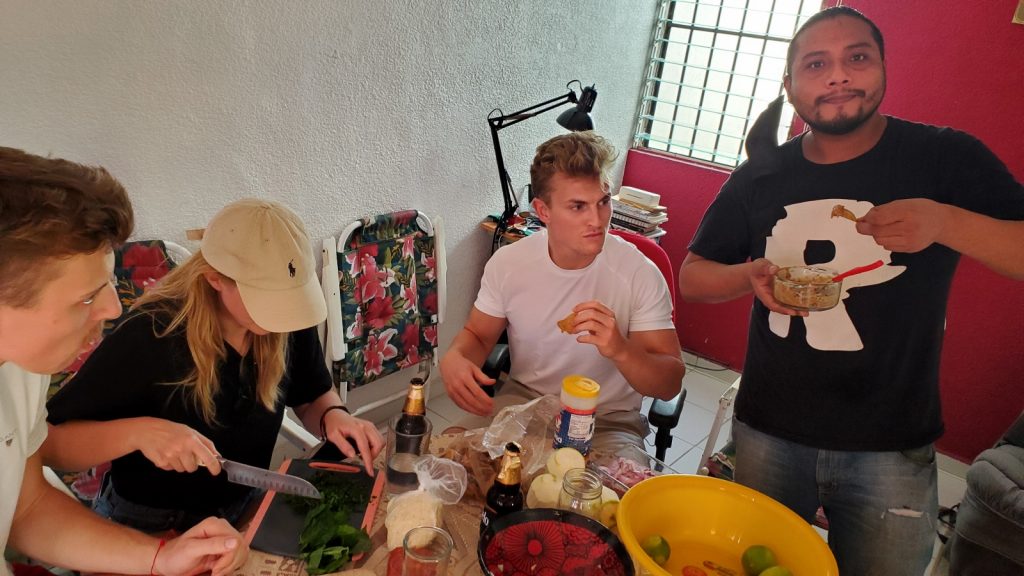
Joachim fired up his grill in his backyard, which was an old car wheel welded to 4 metal rebar legs. “Very Mexican, isn’t it” he proclaimed proudly. We grilled chicken that had been lovingly massaged with some of that red spice paste I mentioned earlier, and shredded it to top the “panuchos” that comprised the main course of our meal. The meal was tasty, although kind of haphazard (Joachim’s home was clearly not quite prepared to host 8 people at once) and consisted of Lima Soup, which is a local citrus fruit (not quite Lime and not quite Lemon) simmered in the oil the chicken was boiled in with toasted tortilla and chicken shreds mixed in) and the panuchos, which are corn tortilla pockets stuffed with a thin layer of refried beans, then layers of avocado, onion, cilantro, and then shredded chicken.
The Germans left soon after dinner (the eldest of them, a 25-year old engineer, had grumbled quietly to Christine that he didn’t think this was very well organized) and Christine and I settled back with some beers to chat with Joachim and Gus as the sun went down. The two of them were a little younger than us and had dreams for an independent Mayan nation, separate of Mexico. Joachim was of mixed Mayan and Filipino ancestry and he and Gus spoke broadly about people of all Mayan heritage coming together to run their own country on the Yucatan. I asked them if any Native Peoples of the USA had ever come down for a tour. They said they had once seen one as a speaker at university, talking about how the Mayans should hold onto and fight for that goal. Since Mayan is still spoken by 30% of all Mexicans, and growing as more and more young people reclaim their culture, this Native of the USA (they didn’t remember which Nation he was with, regretfully) told them they were on the right track.
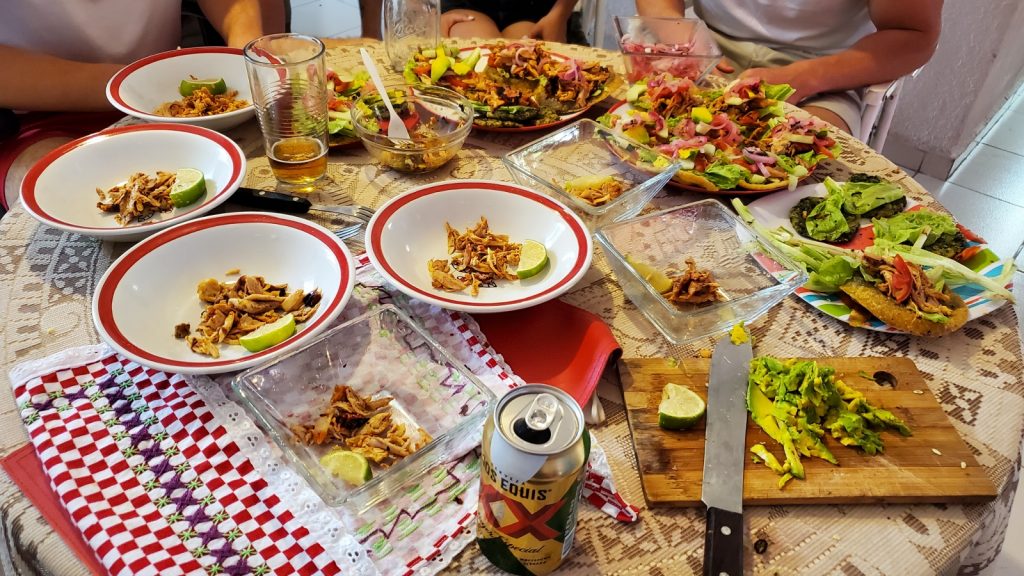
What’s a trip to the Yucatan without a trip to the famous Chichen Itza? Christine had already seen it with her parents many years ago, but together we boarded a 5AM private tour bus with 6 other American tourists, driven by the outgoing and personable Hernan. He had previously worked under a larger tour company, we found out, but lost his job right at the beginning of the pandemic and only a couple months ago had started his own operation with this rented tourist bus. He had some good quality-of-tour ideas, like waiting in line for the 8 of us at the ticket booth so we could all stretch our legs and use the restroom (most other tour buses, we saw, had the tourists wait in line on their own) and getting our tickets for us. He told us that the reason he didn’t include the cost of the entrance tickets on TripAdvisor, where we had found him, is because they always take a 30% cut out off whatever the total amount he listed on their site was. We did end up liking him quite a bit – hit him up on Whatsapp directly at +529841567505 if you’re in Merida and want an all-day tour of the area!
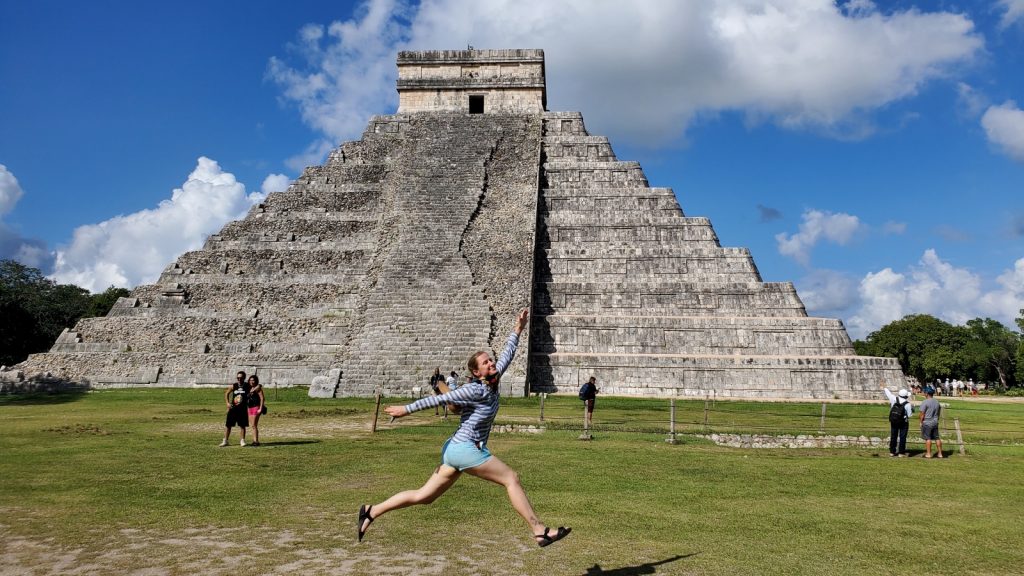
Hernan timed things perfectly so we were the very first tourists through the gate when it opened at 8. We were able to get our typical tourist photos in front of the famous step pyramid without anyone else in them, too. He led us around a few of the ruins and described them with some photos on his tablet showing some discoveries archeologists had made, and then gave us only about 45 minutes to wander – one of his few failings, in my opinion – I wish we had about twice that, but I understand that perhaps I’m a bit more ruins-crazy than the average person. There’s plenty of info out there on the internet about Chichen Itza though of course, so really, these few paragraphs are mostly to give a good nod to Hernan’s service and say the visit was worth the trip. The place was definitely packed by the time we left, around 10:30 – I’m glad we came early.
Our next stop was pretty much the opposite in terms of famous-ness: a privately owned cenote that some friends of his had discovered a decade or so ago while building their home. A cenote is an interesting natural phenomenon almost exclusively unique to the Yucatan peninsula where the earth has formed underground pockets of fresh water, caves that can be dozens of feet across and hundreds of feet deep. The most famous and well-photographed cenotes are open to the air. The ancient Mayans placed their cities near them, including Chichen Itza, and are believed to have made frequent human sacrifices to them. The unlucky were captured enemy warriors, often the strongest, as the Mayans believed that the essentially “bottomless” cenotes were portals to the underworld and powerful blood was needed to be given to the gods. The “lucky” were young children, often of their own nations and villages, who were selected and according to their writings (which were, cough, done by the priests doing the sacrifices) willingly went to their deaths in order to please the gods and perhaps affect the seasons in a beneficial way. Convenient!
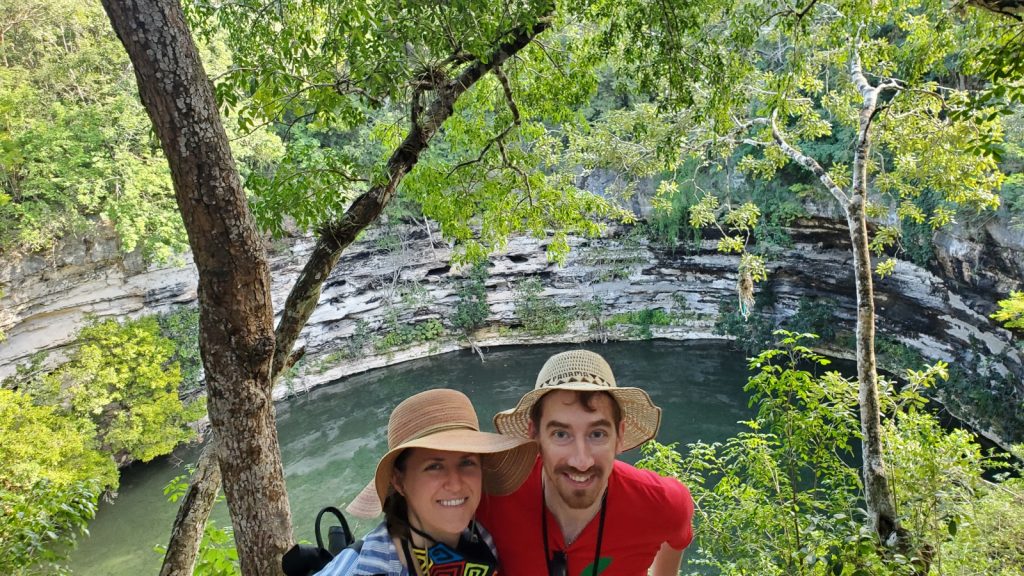
Anyway, this particular cenote had never before seen the light of day until Hernan’s friends were doing their construction work. Ancient cenotes like the ones the Mayans used had their cave ceilings weaken and fall in during prehistory, but this one, and many more around the Yucatan were still sealed bubbles in the rock. We paid the owners 200 pesos, about $10, for a tasty lunch of panuchos, chips and homemade guacamole, and juice and the privilege of a dip in their cenote. After visiting their nearby simple changing rooms they’d built for tourists, a steep and narrow stairway under a sheet metal roof led us down about 30 feet through solid rock, to a concrete platform built at water level in the corner of the cenote, which was roughly spherical with 20 feet of air above us and 20 feet of water below us. A few simple lightbulbs were gaily strung across the stalactited ceiling and were, of course, the only source of light in the place. The water was cool but quite clean, and a the owners told us they’d brought in some variety of catfish to “manage” the cenote’s waters, which after being opened to the air gained quite a few bats – and their guano – and other various algaes and whatnot from people’s skin. The fish were happy to eat this various detritus, it seemed, and keep the pool almost crystal clear. The fish population naturally controlled itself based on how much “food” went into the pool and it seemed, to my unskilled eye, to be working well.
Our fellow tourists were pretty fun. The youngest person on the trip, a Japanese-American from New York traveling with his mother in celebration of his college graduation, was particularly amusing, as he was perhaps the most questioning and talkative person Christine and I had ever seen, even beating out my father and I. He quickly took the front seat of the small bus next to Hernan and eagerly asked him questions for hours as we traveled about. Some highlights were “why does the Cartel exist? Why don’t the police and army just get rid of them?” and “Where do you live? Ah, with your kids. Oh, you’re divorced – do you know how to cook? What do you like to cook?”
The next day we rented some extremely rickety but serviceable single-speed bicycles to take a 5 mile ride to the north part of the city. Christine had heard of a “Christmas Market” and there was also a Mayan history museum. While there were one or two close calls (people around here apparently aren’t used to bicyclists actually using the bicyclist lane on the right side of their 4 lane street and nearly right into us a couple times) all and all it was probably one of the safer and better experiences we’ve had cycling in Latin America just for having a bike lane at all. The Christmas Market was a little smaller than we had hoped, about 30 feet square and run by a couple families, but it did have all the Nativity Figurines and stables to put them into you could want – quite densely packed! We found a Christmas ornament of Our Lady of Guadalupe and continued onto the Museum, just a couple more blocks northward.
For 150 pesos, or about $7, I thought it was a pretty great museum. They had clearly put a lot of thought into organizing it all on a single floor that slowly meandered up and down itself, working backwards through time from how Mayans were a proud and separate, yet well integrated people in Mexico today, all the way back to the earliest detailed writings (that survived Friar Diego’s purgings) about their many Gods and meticulously detailed calendars for everything. For example, if you were going into carpentry, you were given a calendar of when to do everything in each annual cycle – when certain types of wood should be collected, how long it should be dried, when to give an offering before constructing this type of thing versus that one, etc. The Mayans really loved to organize and schedule things! Best of all for me and my lack of Spanish fluency, almost all the exhibits had placards written in Spanish, Mayan, and English, so I didn’t need to depend too much on Christine or a translation phone application.
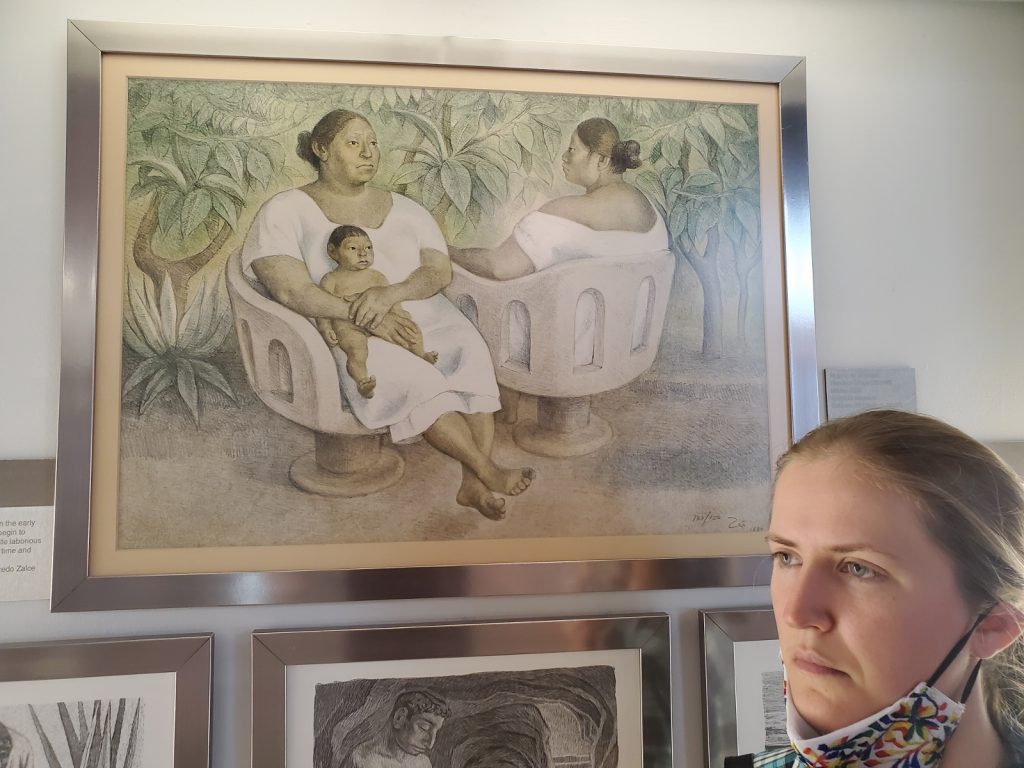
Besides our daily travels, we also had some excellent dinners in Merida, our first evening at a place called “The Mayan House” just north of the central plaza where I tried the famous (it turned out we’d see it sold everywhere at many different price points) “Poc Chu’uc”, a pounded-flat piece of pork fried in oils and spices and topped with more seasonings. We’d end up having it a few times throughout our trip but I think Mayan House did it best – and all for under $8. The Mayan House was also an art gallery and store, and after dinner we chatted with the amiable Mike, whose family owned the store and several others in the area. He spoke English fluently and had grown up in the USA (California) and while he made no secret that he’d be happy to sell us some stuff from his family’s stores, he just seemed happy to chill and chat for a bit. I indulged him and asked him point blank about why his stores were selling crafts more expensively than other vendors like those on the central plaza. He showed us three tiers of shirts his store sold – the cheapest computer-guided sewing machine output that could print off Yucatanean art styles in seconds, then standard human-guided sewing machine work with paper guides on the bottom of the stitches to help the workers follow the pattern (he brushed off some of the paper and it fluttered to the floor) and then finally, the stitched-by-hand work that took weeks of work. “I don’t need you guys to buy anything” he said – “I’ll be honest, last week, I had a lady in here from New York City whose probably reselling our stuff; she bought 90,000 USD worth of our most expensive tapestries and clothing and loaded them into a truck. Good deal for her, I guess; I’ve seen how much ‘authentic’ Mayan crafts go for on the East Coast.” But, just in case we were interested, when he learned it was our honeymoon he told us that sometimes people liked to have a “soul-binding” or “shamanyada” done where a man buys a piece of amber for his wife, and a woman buys a piece of jade for her husband, and then a Mayan shaman blesses and binds the stones’ and the couple’s souls together in a ceremony. Ceremony’s free, he said – if you buy the stones in our store. We were intrigued, but not $100 per stone intrigued!
Our absolute favorite dinner was recommended by the eldest couple on the Chichen Itza tour, a duo in their 60s from Kentucky who had retired 4 years ago, sold their home and cars, and done nothing but travel and see the world since then (pandemic aside, they admitted, when they had to come back to the States and stay with relatives until borders started opening again). They’d clearly had the time and resources to check out “the finer restaurants” and when they mentioned a place called Apoala, also near the center of town, we made a point of checking it out. It was an exquisite Oaxacan style meal of fish in a spicy sauce for Christine, and an expertly-made Oaxacan steak with rich and smoky black mole on it for me. The in-house designed cocktails were also excellent, strong, and with unique flavors. This was the most expensive dinner we had during the entire trip and between an appetizer of chiliquilles to share, 4 cocktails, and 2 entrees the total bill was…80 USD. And this was the sort of place where two waiters came to our table out on a veranda overlooking a park and simultaneously unfolded our napkins and placed them into our laps. Yeah. Have I mentioned that Mexico is extremely affordable? Their menu was pretty small (curated) but I would have eaten there every night – if we had more nights to spend in Merida, which sadly, we do not!
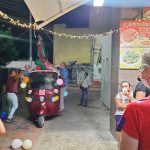

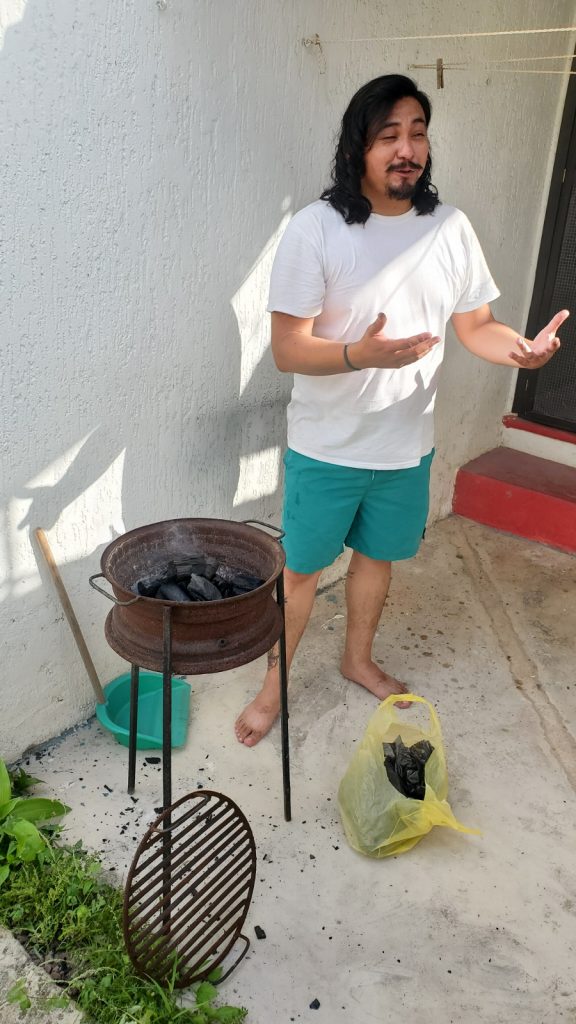
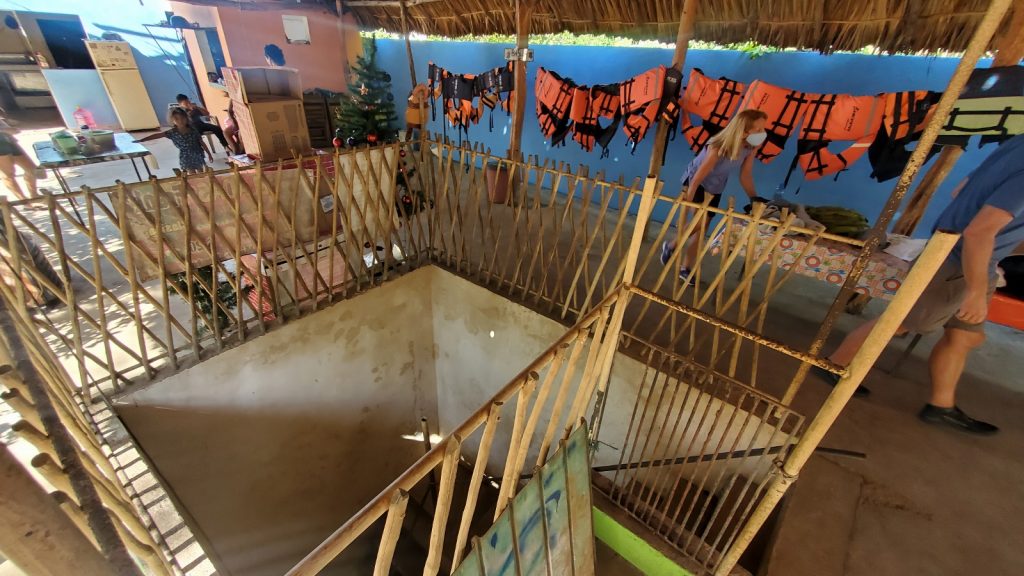
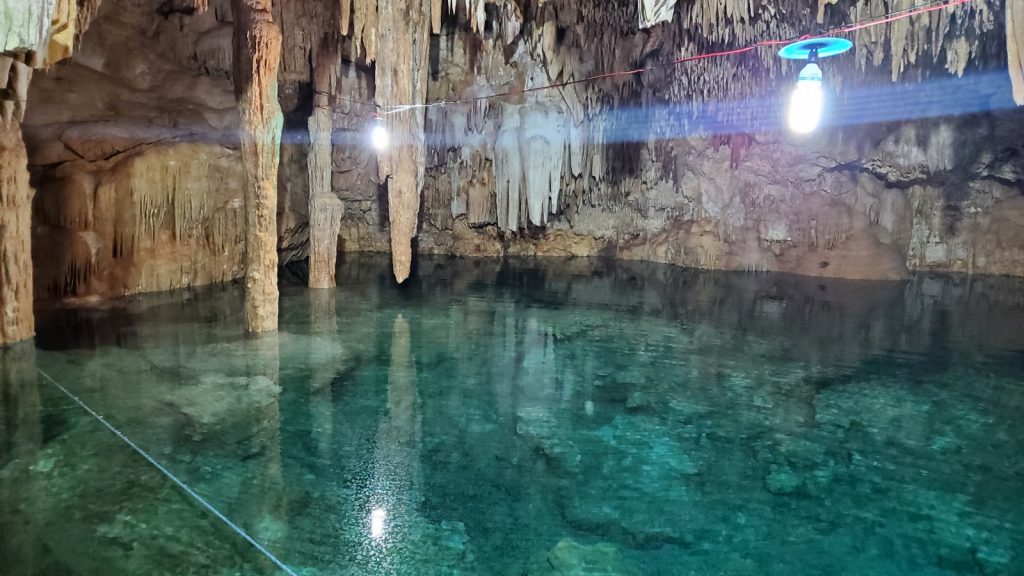
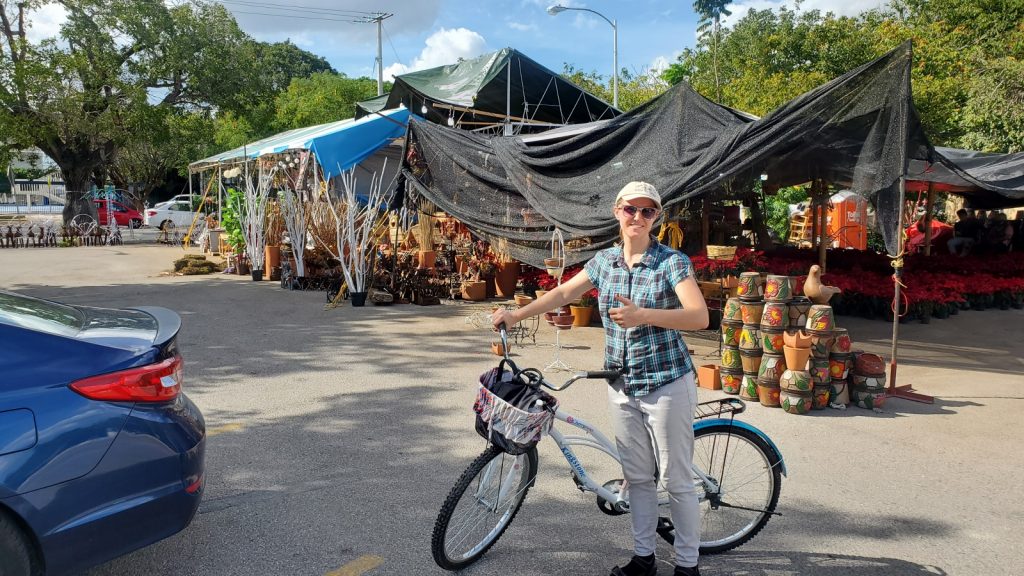
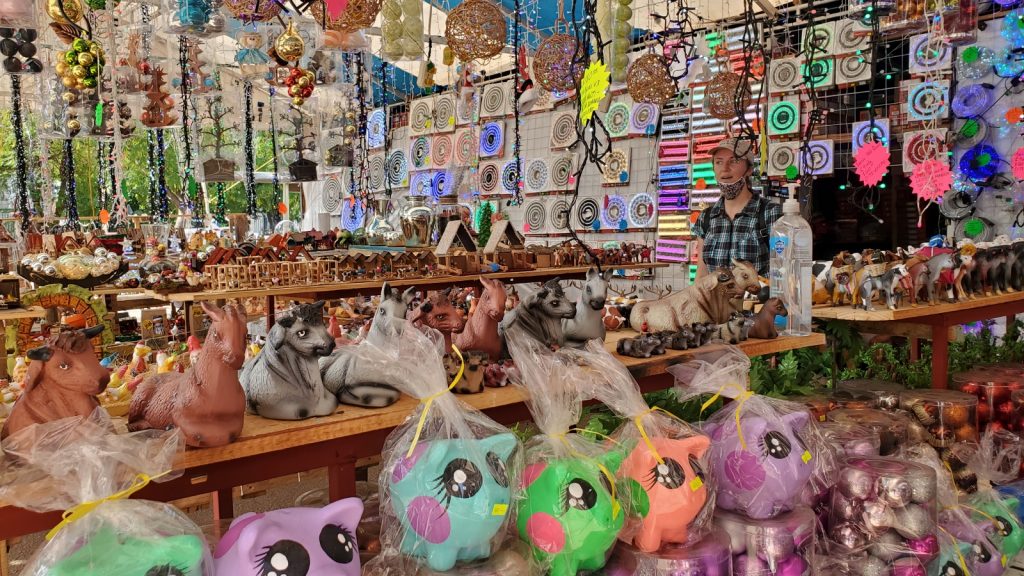
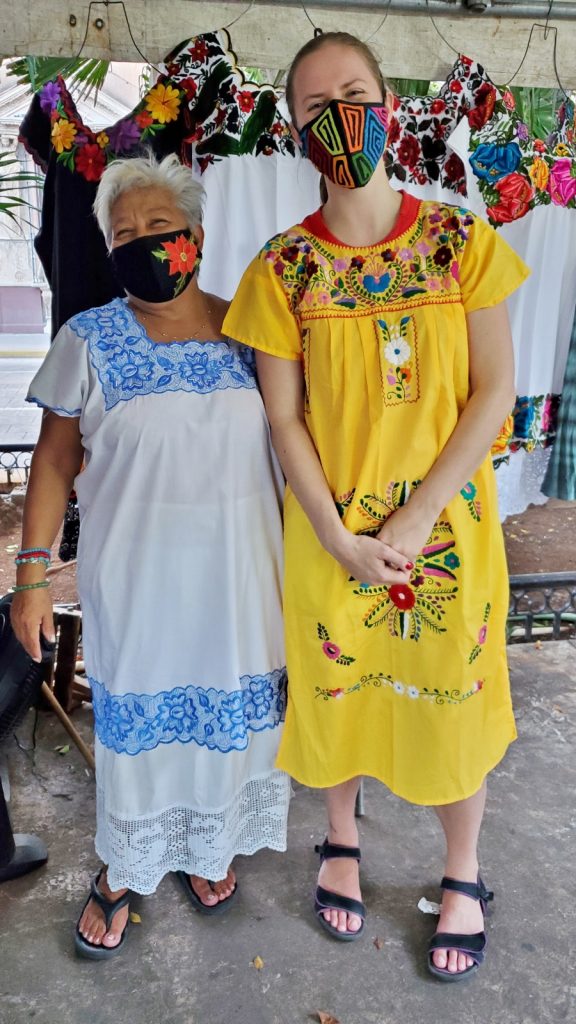


What a wonderful gift– thanks so much for sharing your honeymoon with us. I didn’t try to count the days, but you certainly packed a lot into what time you had. Loved the steampunk tortilla maker. Never heard of or saw a cenote before– fascinating. Your cartel cab ride was unsettling to read about, glad you spent most of your time in less menacing territory! And it looked like the weather was great also, even though we know from the previous post that Christine doesn’t need a jacket no matter what the ambient temperature. I plan to read this again tomorrow. Love to you both.
Just one more comment (tonight). I realized today that I’ll never again see a photo or depiction of the temple at Chichen Itza without seeing Christine doing a sandaled grand jete in the foreground. She brought the past into the present unforgettably. Good on you getting there before the crowds.
But can you be sure about your souls being properly bound without that ceremony? Can you?!